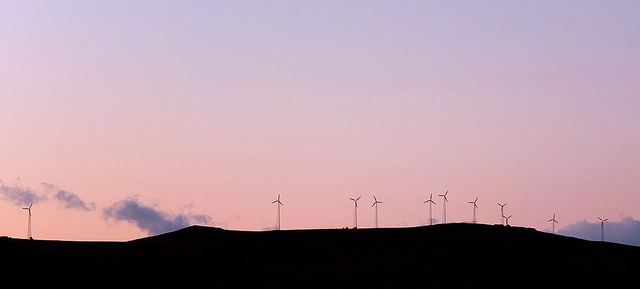This article originally appeared in The Circle 03.15.

Turbines, Nome, Alaska. © The Cabin On The Road / Flickr / Creative Commons
GWEN HOLDMANN is the Director of the Alaska Center for Energy and Power.
It was a blustery day in March when I drove up to the Banner Peak wind farm near Nome, Alaska with John Handeland, manager of Nome Joint Utilities. Nome is a community of 3600 residents located on the edge of the Bering Sea – a stronghold of humanity in a vast expanse of rolling hills, tundra, and taiga. Traditional subsistence hunting and fishing are still very much a way of life here.
My first trip to Nome was 15 years ago, as a competitor in the Iditarod Sled Dog Race. I placed 30th after 12 days traversing 1600 kilometers of Alaska wilderness – including the Alaska Range – hundreds of miles of headwinds up the Yukon River, and a scary crossing of sea ice at Norton Sound. The experience gave me an intuitive feel for the land, the vast distances and challenging terrain. It was also the start of my love affair with the Arctic, including a deep and abiding admiration for the people who call it home.
On this trip, as John and I approached Banner Peak, we could see a crew of workers braving the wind chill to fix the tip brakes on several older model wind turbines that are notorious for having issues in the cold, dense arctic air. Dwarfing these older turbines were two larger, 900kW units better suited to arctic conditions, including direct drives and permanent magnet generators, and black blades designed to absorb heat during the short daylight hours and reduce formation of ice on the blades.
The wind farm represents a partnership between Nome Joint Utilities and Bering Straits (regional) and Sitnasuak (village) Native Corporations, which used private funding to install the original wind farm six years ago. The newer turbines were installed in 2014, supported in part through the Alaska Renewable Energy Fund. This program has funded about three quarters of Alaska’s 70-plus, community-scale renewable energy systems. More than half are wind projects but include small hydro, wind, geothermal, biomass and solar.
Back in the office, John proudly showed me a screenshot from their SCADA (supervisory controller and data acquisition system) that had been taken the previous week. It had been a windy day, and showed that at the moment the screen shot was taken, 50 per cent of Nome’s power was being produced by wind power. For a utility operator in most places, to achieve 50 per cent of their power produced from a variable renewable resource such as wind would be a scary proposition. But in Alaska, this is a common occurrence and necessitated by the fact there is no transmission grid connecting the roughly 250 remote communities in the Alaska ‘bush’. The energy must be consumed where it is produced, and when it is produced. No small feat and John needed to balance a number of both technical and regulatory factors to do it. For example, he can’t run his largest diesel units below 50 per cent of their rated capacity or he could risk being out of compliance with EPA emissions standards – resulting in the ironic situation where John needs to spill wind power and burn diesel when his loads are low and wind speeds high.
The Alaska Center for Energy and Power is working with John to assess how he can optimally manage his diesel fleet, and possibly add a small amount of energy storage, to maximize use of the wind resource. In addition, we conducted a multi-year resource evaluation of a local geothermal resource with over a dozen local partners to determine whether it could supply base load power to the Nome grid. The result was Nome’s second Power Purchase Agreement signed with a private developer, to commit to purchasing 2MW of base load power if (or when) the resources is developed.
Other communities in Alaska are pushing the envelope even further – to the point of being able to turn off the diesel generators entirely when adequate renewably generated power is available. This is accomplished in part by demand management – in particular, dumping excess wind energy into heating loads such as space heating or hot water heating to maintain power quality and that perfect balance between power generated, and power consumed.
The innovation required to design, develop, operate and maintain these high penetration renewable energy systems has led Alaska to quietly become a leader in the development and operation of microgrids – especially microgrids integrating renewable generation. Today, Alaska is home to 12 per cent of the world’s microgrids powered by renewable energy systems, and has more than 2 million hours of continual operating experience for these types of systems. Over 100 small businesses, as well as the Alaska Center for Energy and Power, have gained expertise in this sector and are now venturing out to test global markets for renewably-powered microgrids. Alaskans are now working in such far-flung locations as the South Pacific, Antarctica, and Africa. The Alaska Center for Energy and Power is working with these businesses to develop an organized strategy we hope will lead to a new sort of Alaska export economy – one based on knowledge export, rather than export of non-renewable resources such as crude oil and natural gas.
